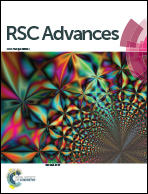The redox mechanism of NpVI with hydrazine: a DFT study†
Abstract
Valence state control and adjustment of neptunium in spent fuel reprocessing is very important for improving the separation efficiency of U/Np and Np/Pu. Hydrazine and its derivatives have been experimentally demonstrated to be effective in the reduction of NpVI to NpV. In this work, hydrazine was used as a representative reductant and the reduction mechanisms of NpVI induced by hydrazine were investigated using density functional theory (DFT) calculations. Three reaction pathways were taken into account and characterized by gradually transferring a hydrogen atom from N2H4 to the “yl”-oxygen of [NpVIO2(H2O)5]2+ followed by the valence state adjustment from NpVI to NpV. The calculated results of the potential energy profiles (PEPs) revealed that Pathway I should be the most likely to occur as the process of forming ˙N2H3 is considered to be the rate-determining step with the highest energy barrier of 32.02 kcal mol−1, which is in favor of the experimental results. Pathway II hardly occurs and Pathway III probably occurs. The bonding evolution, along with the reaction pathways, was explored through natural bond orbitals (NBOs), quantum theory of atoms-in-molecules (QTAIM) and electron localization function (ELF) analyses. This work can shed light on the understanding of redox mechanisms of NpVI with N2H4 and its derivatives and help further attempts to design more efficient reductants for the separation of U/Np and Np/Pu in spent nuclear fuel reprocessing in the near future.


 Please wait while we load your content...
Please wait while we load your content...